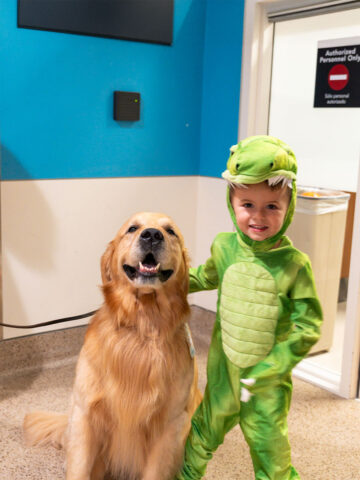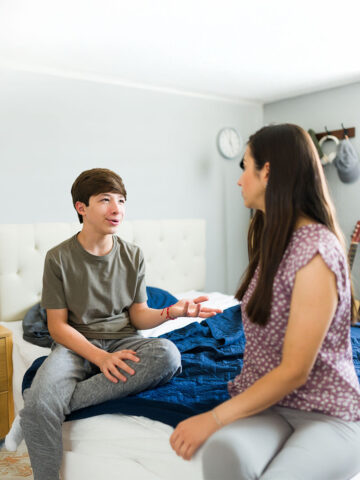During the holiday season, families may put an emphasis on expressing gratitude and thankfulness for the good things in their lives. People often express gratitude when they spend time with loved ones, enjoy wonderful meals, and exchange gifts. The holiday season can also be a challenging one for some people if celebrations look different from others or what they think it “should” be. One way to increase enjoyment of the season or improve your experience during difficult times, is practicing gratitude.
Studies show that gratitude can make a significant, positive impact on a person’s emotional and physical health.
Here, Elizabeth Mu, mental health therapist at CHOC’s Intensive Outpatient Program (IOP), discusses the benefits of practicing gratitude.
What is gratitude?
Gratitude is the act of being thankful for or acknowledging the good things in your life. This could include being appreciative of your friends and family, being thankful for your home, or even being excited that your favorite musician put out new music or that you have time to play a fun video game. Elizabeth says, being grateful means taking the time to reflect and highlight the good things in your lives and what is going well, rather than only focusing on what you don’t have or don’t like about your situation.
Adults and kids often naturally focus on their challenges, as everyone faces many difficulties—and sometimes, people need validation for their tough times. However, constantly focusing on the hard parts of life can start to cause harm if you don’t give enough time and space to the good things. Think of gratitude as a muscle—you need to exercise it regularly to make it stronger.
Why gratitude is good for your kids’ mental health
Focusing on things you like in life sounds great, but how does it really help you and your kids?
Positive psychology research shows that practicing gratitude can improve emotional well-being. It can increase how often someone feels emotions like happiness, pride, and contentment.
“The way you think can be powerful!” Says Elizabeth.
Therapeutic approaches such as Cognitive Behavioral Therapy (CBT) and Dialectical Behavioral Therapy (DBT) often encourage changing the way you think in order to positively impact your emotions and actions. If your child is always focusing on what they didn’t achieve or get, they may start to think negatively about themself and lose hope.
By challenging your child to notice when things (even small things!) go well, they can start to foster more hopefulness which can lead to more hopeful actions.
Making a habit of gratitude can benefit kids and teens because:
- It can pave the way for hopeful possibilities, decisions and actions.
- Gratitude can balance out challenging emotions. Even when your child is having a hard day, encouraging them to identify some good things in their life can help them feel a little bit better.
- Feeling grateful can lead to other desirable emotions like happiness and contentment.
- Gratitude can lead to positive actions. When someone does something nice for you — whether a friend or stranger — and you thank them for it, they’ll be encouraged to do something nice for someone again. Gratitude can start a chain of kindness and thankfulness.
- Being thankful for friends and family strengthens relationships. Expressing gratitude to the people you love can help strengthen your relationship and bring you closer.

Mental Health Education Program (MHEP) webinars
Practical ways to practice gratitude in your family
Expressing gratitude is a skill, and just like any skill, it can be practiced! Use the following ideas to practice expressing gratitude with the whole family:
- As parents, start openly modeling gratitude language. Try pointing out specific things you enjoyed during your day. For example, say, “I’m glad we got all green lights today.” Or, “Wow, this soup is so delicious—I’m thankful for my full tummy.”
- Establish a gratitude ritual. Add gratitude to your family’s daily routine. Have everyone share a few things they’re grateful for. You can do this at dinner, in the car before school, or right before bedtime.
- As a family, try using mindfulness or being intentional with your gratitude. Challenge yourself to notice things you’re grateful for in the moment.
- As parents, model how to express gratitude for everyday things. Show appreciation for what we often take for granted—like a bed to sleep in, electricity, and running water.
- Start a gratitude journal, tree or jar. Every day, have your family members write down something they’re grateful for in a notebook, on a leaf or on a slip of paper. Keep that notebook, tree or jar in a safe place. Weeks or months later, go back and look at everything that was written as a family.
- Practice saying, “thank you.” If you are grateful for someone, tell them! Not only will it make you feel good, it will make them feel good, too.
- Do an act of kindness for someone. Put gratitude into action by volunteering with an organization, writing a thank you note or letter to a friend or family member, dropping off flowers on someone’s porch or paying for the coffee of the person behind you in line.
Gratitude can improve our lives, emotional experience, and relationships. It can be as simple as a “thank you” to someone holding open the door or as big as being grateful to be alive. There are many ways to start practicing this skill and integrating gratitude into your life.
What is one step you’ll take today to invite a little more gratitude into your life?
Get more expert health advice delivered to your inbox monthly by subscribing to the KidsHealth newsletter here.
Get mental health resources from CHOC pediatric experts
The mental health team at CHOC curated the following resources on mental health topics common to kids and teens, such as depression, anxiety, suicide prevention and more.





